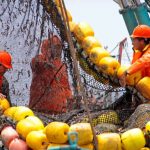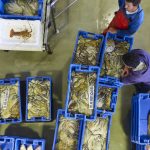Marine Harvest remains impacted by the on-going disease situation in Chile giving a negative operational EBIT of MNOK 65 in the quarter for the group. The biological situation in Chile remains a challenge but Marine Harvest remains confident of a positive long term outcome. The largest operation, Marine Harvest Norway continues to deliver good figures in the first quarter of 2008 with higher harvest volume and lower cost of harvested fish than the same period last year. VAP Europe also continues to show positive development with an increased EBIT.
“We have taken a number of operational actions to contribute to short and long term improvements in Chile, but it takes time to achieve the envisaged improvements. The number of new ISA sites identified has been reducing in the last months, however the overall situation remains uncertain. Still, we are optimistic about the long term outcome for Chile as an attractive and profitable production region. We have taken strong action to reduce cost in the quarter including a closure of one processing plant and the redundancy of 900 staff. Marine Harvest Norway shows good operational improvement compared to last year. The reduction in operational EBIT is to a large extent due to lower market prices and currency effects. We are further pleased with the results in VAP Europe that improved its EBIT despite a lower revenue compared to the same period last year”, says CEO Åse Aulie Michelet.
Marine Harvest generated operating revenues of MNOK 3,080 in the first quarter 2008 compared to MNOK 3,795 for the same period last year. The reduction in revenues of MNOK 715 is mainly a result of lower prices in all regions. The reduction in revenues in Chile alone amounted to MNOK 594, although a large part of this reduction was also due to lower volumes and smaller fish harvested.
EBITDA before fair value adjustment of the biomass and restructuring was MNOK 107 in the quarter, down from MNOK 740 in first quarter 2007. Operational EBIT was negative MNOK 65 in the first quarter of 2008 compared to positive MNOK 552 in the first quarter of 2007.
The total harvest volumes in the first quarter were similar to the levels of the comparable period last year, as the reduction in Chile due to disease was compensated by a volume increase in Norway.
At the end of the first quarter 2008, Marine Harvest had a net interest-bearing debt of MNOK 6,314 compared to MNOK 6,725 in the first quarter 2007 and MNOK 6,744 at the end of 2007. The equity ratio was 53.8 per cent compared to 54.7% in the first quarter 2007.
Business areas
Marine Harvest is divided into five business areas: Marine Harvest Norway, Marine Harvest Chile, Marine Harvest Canada, Marine Harvest Scotland and Marine Harvest VAP Europe (Value Added Products). It also has operational units in Ireland, the Faroe Islands and Japan and halibut farming in Norway.
Marine Harvest Norway had operating revenues of MNOK 1,228 for the first quarter. Operational EBIT was MNOK 93. The harvest volume in the period was record high for a first quarter at 40,353 tonnes (HOG), contributing to an EBIT/kilogram (HOG) of NOK 3.16. EBIT levels were lower than 2007 first quarter due to reduced market prices and currency impacts.
Marine Harvest Chile had operating revenues of MNOK 568 for the first quarter. Operational EBIT was negative MNOK 155. The sold volume in the period was 23,883 tonnes (HOG), giving a negative EBIT margin of EBIT/kilogram 6.48. The negative result was impacted by lower market prices, smaller fish size, lower volumes, and inventory write downs.
Marine Harvest Canada had operating revenues of MNOK 318 for the first quarter. Operational EBIT was MNOK 19. The harvest volume in the period was 11,348 tonnes (HOG), contributing to an EBIT /kilogram of NOK 1.64. The biological situation in Canada remains good. Difficult circumstances with lower prices and falling USD compared with CAD affected negatively the profitability in the first quarter
Marine Harvest Scotland had operating revenues of MNOK 184 for the first quarter. Operational EBIT was negative MNOK 35. The harvest volume in the period was 6,275 tonnes (HOG), resulting in an EBIT/kilogram negative margin of NOK 5.54. Scotland’s underlying performance shows improvement but performance figures were influenced by an incident that led to a product recall. The result includes a provision taken of MNOK 34 to cover the costs of the recall.
Marine Harvest VAP Europe had operating revenues of MNOK 839 for the first quarter. Operational EBIT was MNOK 29, giving an EBIT margin of 3.4% compared to 1.4% in the corresponding period last year. The increase in EBIT margin despite the reduced revenues in the quarter is satisfactory.
Outlook
Marine Harvest expects to harvest a volume of 319,000 tonnes of salmonids in 2008, an increase of 11,000 tonnes compared to the previous guiding, of which 73,000 tonnes will be harvested in the second quarter.
The situation in Chile remains uncertain. The frequency of new ISA outbreaks has been reduced over the last months. However, 2008 will be a challenging year for Marine Harvest Chile. The restructuring of our operations in Chile has the highest priority.
The feed costs are a challenge, for salmon farming as well as for other protein farming industries. Marine Harvest has for the first time negotiated global agreements with our feed supplier. This will be important for the attention we will pay to the use and composition of feed going forward.
Marine Harvest anticipated a breach of one of the covenants in the loan agreement by the end of the first quarter of 2008. However, Marine Harvest has obtained a waiver from the bank syndicate of this financial covenant in relation to the first quarter of 2008. We are in a constructive dialogue with the banks to get the current covenants amended going forward.
The global supply of Atlantic salmon grew by 5% compared to the first quarter last year, significantly below the growth rates we have experienced lately. As a result of the situation in Chile we reiterate a global supply growth of 1-2% for the year and improved market balance in the main markets.
The Board expects improvement in the EBIT for the second quarter compared to the first quarter, reflecting higher prices and slightly lower costs. However, several measures have to be taken to meet the long term financial targets for this business.








